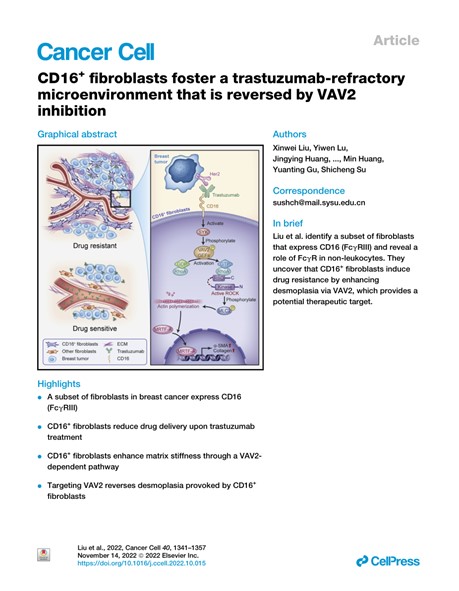Fibroblasts are the most abundant stroma cells in the tumor microenvironment and are important participants in tumor progression. Functional heterogeneity of fibroblasts is increasingly recognized, as accumulating evidence has revealed that carcinoma-associated fibroblasts (CAFs) can exert either pro- or anti- tumor effects. Others and we have identified several CAF subsets with distinct phenotypes and functions by specific markers. For example, CD10+GPR77+ fibroblasts, which are driven by complement signaling, induce chemoresistance by fostering a supporting niche for cancer stem cells. Recently, the research team directed by Prof. Shicheng Su from Sun Yat-sen Memorial Hospital, Sun Yat-sen University, revealed a new mechanism of the pro-tumor effect mediated by Fcγ receptor signals in non-leukocyte cells. This work entitled "CD16+ Fibroblasts Foster a Trastuzumab-Refractory Microenvironment That is Reversed by VAV2 Inhibition" was published online in Cancer Cell on Nov. 14th. Prof. Shicheng Su from Sun Yat-sen Memorial Hospital, Sun Yat-sen University is the corresponding authors. Xinwei Liu, Yiwen Lu, Jingying Huang and Yue Xing are co-first authors.

Here, the researchers identify a subset of fibroblasts in human breast cancer that express CD16 (FcgRIII). An abundance of these cells in HER2+ breast cancer patients is associated with poor prognosis and response to trastuzumab. Functionally, upon trastuzumab stimulation, CD16+ fibroblasts reduce drug delivery by enhancing extracellular matrix stiffness. Interaction between trastuzumab and CD16 activates the intracellular SYK-VAV2-RhoA-ROCK-MLC2-MRTF-A pathway, leading to elevated contractile force and matrix production. Targeting of a Rho family guanine nucleotide exchange factor, VAV2, which is indispensable for the function of CD16 in fibroblasts rather than leukocytes, reverses desmoplasia provoked by CD16+ fibroblasts. Clinically, the researchers reveal a role for the fibroblast FcγR in drug resistance, and suggest that VAV2 is an attractive target to augment the effects of antibody treatments.
In summary, the researchers uncover the function of FcγRs in non-leukocyte cells in tumor microenvironment for the first time and provide a feasible target of antibody treatments which abolishes the pro-tumor effect of FcγR signals in CAFs, whereas has no obvious impact on the anti-tumor effect of FcγR signals in immune cells.
Link to the article: https://doi.org/10.1016/j.ccell.2022.10.015



